Ceramic tableware is a kind of tableware often used in people's daily life, with elegant, beautiful, safe, and environmental protection and other characteristics, and has become an important part of modern home life.
This article will introduce ceramic tableware from its history, materials, production process, and the use of precautions.
The history of ceramic tableware can be traced back to the Neolithic period of China, thousands of years ago. Ceramic tableware in China has experienced a long journey from crude to exquisite, from monochrome to colorful.
Nowadays, ceramic tableware such as celadon, and white porcelain have become the most famous varieties of porcelain in the world.
The main material of ceramic tableware is porcelain clay and quartz sand and other natural minerals, which are sintered at high temperatures.
Porcelain clay is a fine-grained clay, mainly composed of silicate, with excellent whiteness and toughness. Quartz sand is a hard mineral that increases the hardness and wear resistance of ceramic tableware.
The production process of ceramic tableware is a complex process, including the screening of raw materials, making the original blank, glazing, decoration, firing, and many other aspects.
Among them, making the blank is one of the key links. A roughly corresponding billet is made according to the final shape of the ware and is allowed to dry naturally for some time.
Glaze is applied to the finished billet and then fired to make the glaze fuse with the billet as one.
The decoration is the painting of patterns and designs on the surface of the porcelain after glazing.
Firing is the ceramic tableware that is put into the kiln, high-temperature firing so that it has heat, cold, acid, and alkali-resistant properties.
Ceramic tableware in the use of the following points needs to be noted:
1. Avoid collision when using: ceramic tableware is fragile and needs to be used carefully to avoid collisions, falls, and other situations.
2. Slow temperature change: ceramic tableware temperature change should be slow, not sudden changes, otherwise it is easy to produce thermal cracking.
3. For Cleaning pay attention to ceramic tableware in cleaning can not use metal tools, you should use a soft cloth or sponge for cleaning, to avoid scratching and wearing ceramic surfaces.
4. Dry and ventilated when stored: ceramic tableware in storage should be placed in a dry and ventilated place to avoid moisture and mold.
Ceramic tableware is an important household item, adding elegance and beauty to our daily table. In the use of ceramic tableware, we need to pay attention to its material, and production process and use precautions to better protect it and extend its service life.


